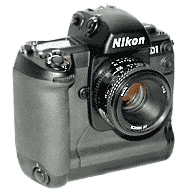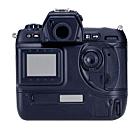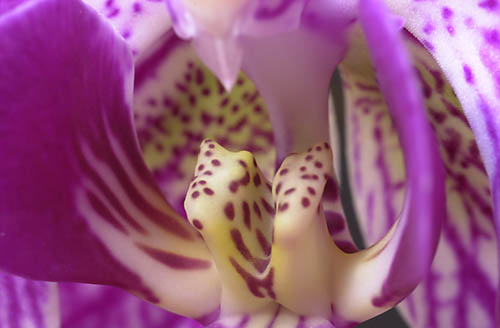 The
D1 is Nikon's first foray into professional digital SLRs. I've now been using my
D1 for about a couple months and I'm quite impressed with the way it handles and
performs. For many applications, I could see the D1 replacing film-based pro
SLRs. The image quality is not quite as high as is possible from 35mm film, but
it's still possible to create 14x20 inch prints that are marginally fine-art
quality.
The
D1 is Nikon's first foray into professional digital SLRs. I've now been using my
D1 for about a couple months and I'm quite impressed with the way it handles and
performs. For many applications, I could see the D1 replacing film-based pro
SLRs. The image quality is not quite as high as is possible from 35mm film, but
it's still possible to create 14x20 inch prints that are marginally fine-art
quality.
I've heard that the D1 is based on the F5 chassis, but it seems to be a mix
of the F5 and F100. Its size, weight, handling, and balance are about the same
as the F5. It doesn't have the locks on the controls like the F5 does, but all
the controls are pretty much the same.
The D1 has a 2.74 Megapixel CCD Imaging Sensor with 2,000 x 1,312 CCD
elements. It has a build in Lithium Niobate low pass filter to reduce aliasing
and provide beautiful image smoothness, but this also tends to soften the image
somewhat. The CCD has large 11�m pixel elements which result in excellent noise
characteristics for a digital camera, particularly when the sensitivity is set
to ISO 200.
Images are captured in TIFF or one of three JPEG formats, and can also be
transferred via firewire directly off the camera in a raw format. I generally
use the highest quality JPEG format and have been very satisfied with the
results.
Probably the most impressive aspect of the camera is its speed. It responds
just like the F5. Turn the camera on and it's ready to take a photo. There is no
noticeable delay for the camera to "boot" like other digital cameras.
Push the shutter button and it takes a picture, or a burst of pictures,
instantly. There is no perceptible delay. The camera can take a burst of
pictures at up to 4.5 per second in bursts of up to 21 pictures. In the time
I've used the camera, I've never had a situation where it wasn't ready to take a
picture when I was.
I'm using a 128MB Sandisk CompactFlash card in my camera. According to Nikon,
this should hold 88 images in high quality JPEG mode, but I've found that I can
typically get over 100 images before the CF card fills. I assume that this is
because JPEG is not a fixed compression ratio and 88 is a conservative estimate.
 The D1 has a 2 inch diagonal color LCD monitor on the back which
provides access to menus, display of images, thumbnails (3x3 images, as if the
small 2 inch display wasn't already small enough), data display (lens, exposure,
time, etc.) and histogram. When you're looking at images, a course, very low
resolution version of the image is displayed first, followed about a second
later with a more detailed version. The LCD is protected with a snap-on plastic
cover. I guess this is better than a cover that swings out of the way since this
would likely get broken off, but I can easily see this cover getting lost. The
LCD seems to be in just the right position to get smudged by your nose as you're
looking through the viewfinder, so you'll generally want to keep the cover on.
The LCD can be cleaned with lens cleaning towelettes or those designed for
cleaning CRTs.
The D1 has a 2 inch diagonal color LCD monitor on the back which
provides access to menus, display of images, thumbnails (3x3 images, as if the
small 2 inch display wasn't already small enough), data display (lens, exposure,
time, etc.) and histogram. When you're looking at images, a course, very low
resolution version of the image is displayed first, followed about a second
later with a more detailed version. The LCD is protected with a snap-on plastic
cover. I guess this is better than a cover that swings out of the way since this
would likely get broken off, but I can easily see this cover getting lost. The
LCD seems to be in just the right position to get smudged by your nose as you're
looking through the viewfinder, so you'll generally want to keep the cover on.
The LCD can be cleaned with lens cleaning towelettes or those designed for
cleaning CRTs.
The D1 can connect to your computer using a 1394 firewire cable or plugging
the CompactFlash card into a PC-Card adapter. Some CF cards also come with USB
readers which allows you to connect this way. One thing I was a little upset
about, though, is that the 1394 interface will only work with two Adaptec 1394
cards. It is not compatible with Sony's iLink interfaces (those used by DV
camcorders), so you can't plug your D1 directly into your Sony laptop.
The sensitivity of the CCD can be set to 200, 400, 800 and 1600, and with
custom function selections can be set to 3200 and 6400. It's not clear why Nikon
didn't make these two faster settings selectable in the same way. Image quality
degrades fairly quickly as you increase the sensitivity, but I've been very
impressed with the filters available in QImage software
to eliminate this noise.
One of the challenges faced by digital cameras is TTL flash support. TTL
flashes generally work by measuring the light reflected off the film during the
exposure. CCDs do not have the same reflectance properties as film and do not
produce accurate readings. Nikon has solved this problem by creating a special
version of their SB-28 flash which does a preflash just before the shutter
opens. The D1 measures the light reflected off the back of the shutter curtain
(which is specially coated for this purpose) and then controls the flash
duration during the actual exposure. In practice, this works very well.
The D1 uses an interchangeable NiMH battery pack which seems to last for
about 120 or so pictures, depending on how much autofocusing is done. The
battery pack can be exchanged in about 5 seconds - less time than it takes to
swap out the CF card.
I have noticed a few specs on the images I've taken, I assume from dust on
the CCD array. With a removable lens, there is no way to completely seal the
camera from dust.
Overall, an impressive first attempt at a digital replacement for a pro SLR.
It's very easy to handle, and if you've already got an F100 or F5, you'll feel
right at home with this camera. The photo below of an orchid close-up was one of
the first photos I shot with the D1.

 The
D1 is Nikon's first foray into professional digital SLRs. I've now been using my
D1 for about a couple months and I'm quite impressed with the way it handles and
performs. For many applications, I could see the D1 replacing film-based pro
SLRs. The image quality is not quite as high as is possible from 35mm film, but
it's still possible to create 14x20 inch prints that are marginally fine-art
quality.
The
D1 is Nikon's first foray into professional digital SLRs. I've now been using my
D1 for about a couple months and I'm quite impressed with the way it handles and
performs. For many applications, I could see the D1 replacing film-based pro
SLRs. The image quality is not quite as high as is possible from 35mm film, but
it's still possible to create 14x20 inch prints that are marginally fine-art
quality. The D1 has a 2 inch diagonal color LCD monitor on the back which
provides access to menus, display of images, thumbnails (3x3 images, as if the
small 2 inch display wasn't already small enough), data display (lens, exposure,
time, etc.) and histogram. When you're looking at images, a course, very low
resolution version of the image is displayed first, followed about a second
later with a more detailed version. The LCD is protected with a snap-on plastic
cover. I guess this is better than a cover that swings out of the way since this
would likely get broken off, but I can easily see this cover getting lost. The
LCD seems to be in just the right position to get smudged by your nose as you're
looking through the viewfinder, so you'll generally want to keep the cover on.
The LCD can be cleaned with lens cleaning towelettes or those designed for
cleaning CRTs.
The D1 has a 2 inch diagonal color LCD monitor on the back which
provides access to menus, display of images, thumbnails (3x3 images, as if the
small 2 inch display wasn't already small enough), data display (lens, exposure,
time, etc.) and histogram. When you're looking at images, a course, very low
resolution version of the image is displayed first, followed about a second
later with a more detailed version. The LCD is protected with a snap-on plastic
cover. I guess this is better than a cover that swings out of the way since this
would likely get broken off, but I can easily see this cover getting lost. The
LCD seems to be in just the right position to get smudged by your nose as you're
looking through the viewfinder, so you'll generally want to keep the cover on.
The LCD can be cleaned with lens cleaning towelettes or those designed for
cleaning CRTs. 